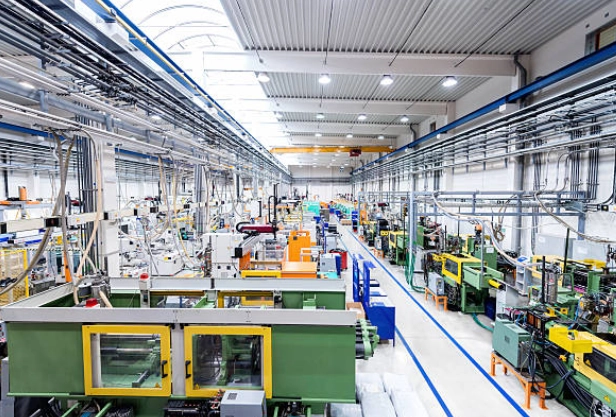Finding the Best Plastic
When picking plastic for electronic enclosures injection, check if it fits your needs. You want a material that keeps your product safe where it’s used. Choosing carefully is important. Each plastic has special traits for different jobs. Whether you’re making a waterproof sensor case or a strong industrial controller, knowing what each material does best helps get good results.
Acrylonitrile Butadiene Styrene (ABS)
ABS is a really tough plastic. It’s low-cost and makes sturdy enclosures for rough use. You’ll see it in cars, fridges, suitcases, toys, and gauges.
It’s bendy, glossy, takes bumps well, and blocks electricity. It works in cold down to -4°F. Its glass transition point is 105°F, and it melts at 392°F. But sunlight harms it. So, it’s not good for outdoor use.
Acrylonitrile Styrene Acrylester and Polycarbonate (ASA+PC Blend)
Mixing Acrylonitrile Styrene Acrylester (ASA) with Polycarbonate (PC) makes a plastic that handles stress and heat well. It’s used in car parts and injection molding without paint.
It works nicely in hot or cold weather, resists impacts well, fights chemicals, stops UV rays and water, and meets the UL 94 V-0 flame-resistance standard.
Polyamide (PA)
Polyamides are found in nature, like in wool and silk. Man-made ones are used for cable ties and power tool cases.
It’s strong, holds up to wear, slides easily, and is a great electrical insulator. But it soaks up water. This makes it bad for wet or humid spots.
Polybutylene Terephthalate (PBT)
PBT is used for high-heat electronic enclosures. This plastic polyester is common in plug connectors and car parts.
It resists chemicals and stress. It also does well in hot conditions. But its crystal structure causes shrinking, making it hard to switch to plastics like PC or ABS.
Polycarbonate (PC)
Polycarbonate is in the polyester family. It’s a popular plastic because it’s strong and bendy for jobs where metal isn’t right.
It’s clear, super tough—30 times stronger than acrylic and 250 times stronger than glass—blocks UV rays, handles temperatures from -4°F to 284°F, is light, and is easy to cut or shape on-site.
It’s great for outdoor use alone or in ASA+PC-FR blends for extra toughness. But it has BPA, so it’s not safe for some sensitive uses.
Polycarbonate + Acrylonitrile Butadiene Styrene (PC+ABS Blend)
A PC+ABS blend combines the best of PC and ABS. It’s used a lot in electronics, telecom, and car industries.
It has strong impact resistance, works in cold weather, resists chemicals well, and meets the top UL 94 V-0 flame-resistance standard. It’s best for indoor or limited outdoor enclosures. It handles mild corrosive conditions nicely.
Polymethyl Methacrylate, Acrylic, Plexiglas (PMMA)
Known as acrylic glass or Plexiglas, PMMA is used when you want clear plastic without polycarbonate.
It’s see-through, light, and shatter-resistant—17 times stronger than glass. Some types let through up to 92% of light and work with infrared.
But PMMA isn’t as tough as ABS. It can break easily. It’s often paired with ABS parts for extra strength.
Polyphenylene Ether + Polystyrene (PPE+PS)
This mix of Polyphenylene Ether (PPE) and Polystyrene (PS) is used in transformer housings or relay cases. It has great electrical properties.
It offers strong mechanical traits and stays stable in heat. But UV light can change its color. So, it’s best for indoor use.
Styrene Ethylene Butadiene Styrene (SEBS)
SEBS is a soft, rubbery plastic, perfect for handheld device cases because of its comfy feel.
It resists weather and chemicals and feels good to hold. It’s also an eco-friendly swap for PVC in small toys or consumer products.

Why Choose Silkbridge for Plastic Enclosures Production
Silkbridge makes top-notch plastic enclosures for electronics, industrial devices, and consumer goods. Using advanced injection molding, we create precise, sturdy, and custom-designed enclosures.
Our skills include multi-cavity molding, over-molding, and insert molding for solutions that fit different industries. We use many engineering plastics with features like impact resistance, heat stability, and smooth finishes.

From mold design to prototypes to mass production, Silkbridge ensures every plastic enclosure for electronics meets global standards. We handle electronics housings and waterproof outdoor cases.
Whether you’re building IoT devices or tough industrial controllers, Silkbridge provides trusty solutions made for top performance.
- WhatsApp: +86 18122838771
- Phone: +86 18122838771
- Email:contact@silkbridgeltd.com
FAQ
What should I consider when choosing a plastic enclosure?
Think about sunlight or water exposure, needed strength, chemical risks, flame resistance, and design needs like color or clarity.
Some traits to check include UV resistance, chemical resistance, temperature tolerance, flame resistance, color options, transparency, moisture resistance, impact resistance, and stress resistance.
Which plastics are best for outdoor electronic enclosures?
ASA+PC blends, Polycarbonate, and SEBS are excellent. They resist UV, weather, and water. Avoid ABS unless it’s for indoor use.
Can Silkbridge help design custom enclosures?
Yes. Silkbridge offers a full service, from mold design and prototyping to mass production. Each enclosure meets strict industry standards.


